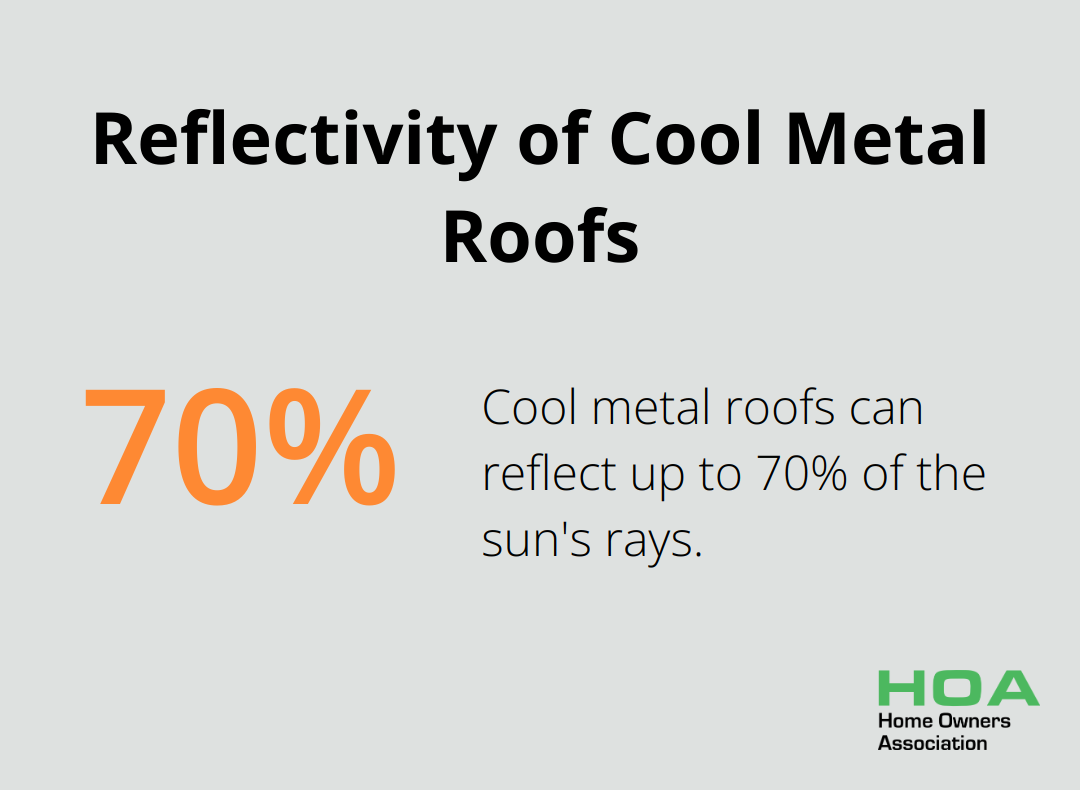
At Home Owners Association, we’re excited to explore the world of sustainable building materials. These eco-friendly alternatives are revolutionizing the construction industry, offering both environmental benefits and innovative solutions for homeowners.
In this post, we’ll examine recycled and reclaimed materials, cutting-edge sustainable options, and energy-efficient choices that can transform your next building project. Join us as we uncover how these materials can reduce your environmental impact while creating beautiful, durable homes.
Recycled Materials Transform Construction
At Home Owners Association, we’ve observed a significant shift towards recycled materials in construction. This trend isn’t just about environmental consciousness; it’s about smart, cost-effective building practices that benefit both homeowners and the planet.
Recycled Concrete: A Sustainable Powerhouse
Recycled concrete leads the charge in sustainable construction. The Construction & Demolition Recycling Association reports that using recycled concrete can reduce landfill waste by up to 80%. This material, often called recycled concrete aggregate (RCA), is created by crushing existing concrete structures and repurposing them for new projects.

RCA isn’t just environmentally friendly; it’s also cost-effective. Implementing RCA for new pavement can minimize carbon footprint, conserve natural resources, reduce harmful emissions, and lower life cycle costs.
Steel: The Infinitely Recyclable Marvel
Steel is another game-changer in recycled construction materials. The American Iron and Steel Institute confirms that steel is 100% recyclable and can be recycled indefinitely without loss of quality. This makes it an excellent choice for sustainable building projects.
Recycling steel requires considerably less energy compared to primary production. The energy savings translate into lower environmental impact and potentially lower costs for steel-framed structures or reinforced concrete elements.
Reclaimed Wood: Beauty with History
Reclaimed wood has gained popularity in home construction and renovation projects. This material, often sourced from old barns, factories, or warehouses, brings character and history to new builds while reducing demand for freshly harvested timber.
The Environmental Protection Agency estimates that reclaiming wood for reuse can reduce landfill waste by up to 8,000 pounds for every 1,000 square feet of deconstruction. For homeowners, this means unique, high-quality wood with a lower environmental footprint.
A prime example of successful recycled material use is the Bullitt Center in Seattle. This six-story commercial building incorporated salvaged materials throughout its construction, including reclaimed wood for its floor decking. The result is a stunning, environmentally friendly structure that serves as a model for future sustainable building projects.
As the construction industry continues to evolve, recycled and reclaimed materials stand at the forefront of sustainable construction. These innovative options not only contribute to a more sustainable future for Australian construction but also open up exciting possibilities for homeowners. In the next section, we’ll explore cutting-edge sustainable building materials that are pushing the boundaries of eco-friendly construction even further.
Innovative Building Materials Revolutionize Construction
At Home Owners Association, we explore cutting-edge materials that transform the construction industry. These innovative options offer environmental benefits and unique advantages for homeowners. Let’s examine three game-changing materials that reshape how we build.
Bamboo: Nature’s Steel
Bamboo has emerged as a powerhouse in sustainable construction. This fast-growing grass reaches maturity in just 3-5 years (compared to 10-20 years for most softwoods). Its rapid growth rate makes it an incredibly renewable resource.
Bamboo isn’t just sustainable-it’s also incredibly strong. While its strength properties are impressive, it’s important to note that recent studies have shown that alternative materials in concrete, such as a combination of fly ash, GGBS, and m-sand, can improve compressive and split tensile strengths.
In Australia, companies offer bamboo flooring, decking, and even structural bamboo for load-bearing applications. These products provide homeowners with durable, beautiful, and eco-friendly options for their projects.
Hempcrete: The Carbon-Negative Wonder
Hempcrete is another innovative material that gains traction in sustainable construction. This biocomposite material consists of the inner woody core of the hemp plant mixed with a lime-based binder.
One of the most remarkable properties of hempcrete is its ability to sequester carbon. Research indicates that hempcrete can sequester 307 kg of CO2 per cubic meter, roughly equivalent to the annual carbon emissions of some individuals. This makes it a carbon-negative material, actually removing more CO2 from the atmosphere than it produces during manufacturing.
Hempcrete also offers excellent insulation properties. Its porous structure allows it to regulate humidity, creating a healthier indoor environment. While it’s not yet widely available in Australia, companies work to bring this innovative material to the mainstream construction market.
Mycelium: Fungi for the Future
Perhaps the most futuristic of our innovative materials is mycelium. This material derives from the root structure of fungi and can grow into almost any shape.
Mycelium has impressive insulative properties and is naturally fire-resistant. It’s also incredibly lightweight, which makes it easy to transport and work with. Companies pioneer the use of mycelium in construction, creating insulation panels and even entire tiny houses from this fungal material.
While mycelium-based construction products aren’t yet widely available in Australia, the potential for this material is enormous. As research continues and production scales up, we anticipate seeing more mycelium-based options for Australian homeowners in the near future.
These innovative materials represent just a fraction of the exciting developments in sustainable construction. In the next section, we’ll explore energy-efficient materials that not only contribute to sustainability but also help homeowners save on energy costs.
Energy-Efficient Materials for Smarter Homes
Energy-efficient materials have become increasingly popular among Australian homeowners. These materials contribute to a more sustainable future and offer significant cost savings on energy bills. Let’s explore some of the most effective energy-efficient materials that can transform your home into a model of efficiency.
High-Performance Insulation: The Silent Energy Saver
Insulation plays a crucial role in energy efficiency for homes. Heating and cooling together use the largest amount of energy in the average Australian home, accounting for around 40% of household energy use. This highlights the importance of proper insulation for substantial energy savings and increased comfort for homeowners.

Aerogel insulation stands out as an exceptional option. This ultra-light material (originally developed by NASA) offers exceptional thermal performance. With a thermal conductivity as low as 0.014 W/mK, it outperforms traditional insulation materials by a significant margin.
Phase change materials (PCMs) present another innovative choice. These substances absorb and release heat as they change from solid to liquid and back, which helps maintain a consistent indoor temperature. PCMs can be incorporated into building materials or used as a standalone solution, potentially reducing heating and cooling energy consumption by up to 30%.
Smart Glass: Windows That Work for You
Windows often act as a weak point in a home’s thermal envelope, but smart glass technology changes that. Also known as electrochromic glass, this innovative material can change its tint in response to electrical currents, effectively controlling heat gain and glare.
Recent studies show that smart glass can provide energy savings in residential buildings. For example, a passive house showed 1.3-3.1% mean energy savings with electrochromic glass, while an IECC dwelling demonstrated 4.4-5.1% savings.
Low-E (low-emissivity) glass offers another excellent option. This specially coated glass reflects heat while allowing light to pass through. The CSIRO reports that Low-E windows can reduce heat gain by up to 33% compared to standard glass, making them an effective choice for energy-conscious homeowners.
Cool Roofing: Your Home’s Temperature Regulator
Cool roofing materials reflect more sunlight and absorb less heat than standard roofing products. In Australia’s hot climate, these materials can make a substantial difference in a home’s energy efficiency.
Metal roofs coated with solar-reflective paint can reflect up to 70% of the sun’s rays, significantly reducing heat absorption. This can lead to energy savings of up to 20% for cooling costs (according to studies by the Lawrence Berkeley National Laboratory).

For those who prefer tile roofs, light-colored concrete tiles offer excellent thermal performance. These tiles can reflect up to 77% of solar radiation, which helps keep homes cooler and reduces the load on air conditioning systems.
Implementing these energy-efficient materials in your home can lead to substantial energy savings and increased comfort. Many innovative materials are now more accessible and affordable, making it easier to upgrade your home’s energy efficiency. Investing in energy-efficient materials creates a more sustainable and environmentally friendly home for the long term.
Final Thoughts
Sustainable building materials represent a significant shift in construction, offering reduced environmental impact and high-quality, efficient homes. We anticipate exciting developments in eco-friendly construction, including advancements in material science and improved manufacturing processes. The integration of smart technologies with sustainable materials will likely enhance energy efficiency and home performance further.
Homeowners who consider renovation or new construction projects should explore sustainable building materials. These options contribute to a healthier environment and can lead to long-term cost savings through improved energy efficiency and durability. The choice of sustainable materials is an investment in the future of your home and our planet.
At Home Owners Association, we support Melbourne homeowners in making informed decisions about sustainable building materials. Our members receive expert advice, access to trade pricing, and resources to ensure their projects meet high standards of quality and sustainability. We guide homeowners through the process of incorporating sustainable building materials into their homes, whether for major renovations or small upgrades.





